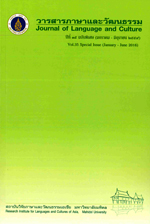Japanese museum: A media of cultural transmission
Main Article Content
Abstract
This paper presents a new perspective on Japanese museums. In contemporary context, Japanese museum has been developed to become as a media of cultural transmission along with globalization. Japanese museums have been use as an equipment to build a strong cultural unity from local diversity and present national stories through the museum at the same time. Nowadays, world known Japan as one of the strongest cultural country. Many museums in Japan are more than place, but a space of interaction between insider and outsider, like living room of community. This interaction can bring their stories to become like cultural products, as “Invisible goods” which can be exported from the museums. Furthermore, the integration between Japanese museums and both nationallocal tourism plans, as a form of cultural communication, make museums take a role like “soft power media” which can extend “Japanese” to the world along with globalization in contemporary society.
Article Details
The articles featured in the Journal of Language and Culture (JLC) constitute academic works representing the viewpoints of the respective author(s). It is crucial to note that these opinions do not necessarily reflect those of the Editorial Board.
All articles published in JLC are released under the Creative Commons Attribution 4.0 International License (CC BY 4.0). This license grants permission for unrestricted use, distribution, and reproduction in any medium, provided proper credit is given to the original author(s) and the source.
References
and society. Retrieved from https://www2.le.ac.uk/departments/museumstudies/museumsociety/documents/volumes/chang28.pdf
Ohtsuka, K. (2009). History of Museum in Japan, a paper of course of Museology by JICA 2009 at the National Museum of Ethnology, Osaka.
Osaka Museum of History. (2004). Permanent Exhibition Guide, Osaka.
Tamami Fukuda. (2000). Representing Our Region: Cultural Conservation and Local Museum in Japan. Retrieved from http://econgeog.misc.hit-u.ac.jp/icgg/intl_mtgs/TFukuda.pdf


